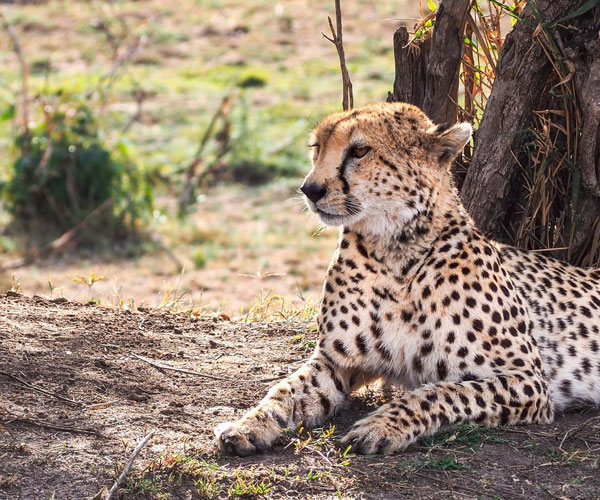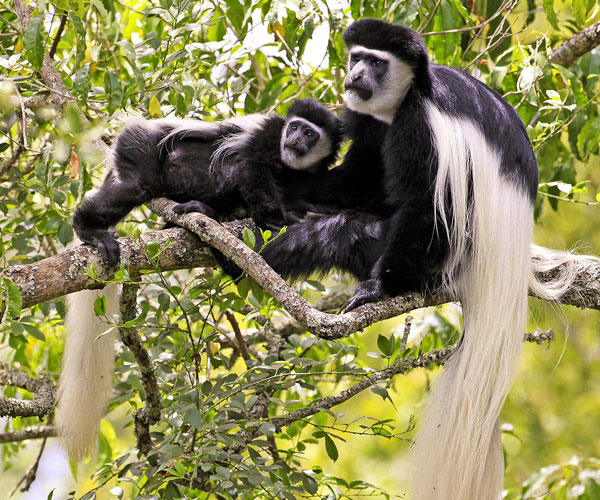Arusha National Park
Where the magic happens at nature's pace
Find Your ExperienceArusha National Park is a gem of varied ecosystems and spectacular views of Mt. Meru, the crater that gives the region its name. With Arusha National Park, you don't have to travel too far after landing to find yourself surrounded by the African bush. Canoeing, walking safaris, and game drives are some of the best things to do here and make for the perfect start to any Tanzania Safari Tours.
Situated just a short drive from Arusha and Moshi, Arusha National Park is one of Tanzania's most
At just over 200 square miles, Arusha National Park has great wildlife densities, and it is home to the world's largest population of giraffe.
Arusha National Park can generally be explored in a day and is a great stand-alone adventure due to its proximity to Arusha and Moshi, and thanks to its small size.
It also pairs well with longer itineraries on the northern safari circuit, including the Ngorongoro Conservation Area and Serengeti National Park.
If you're looking to squeeze in a short Tanzania Safari after climbing the steep slopes of Mount Meru, Arusha National Park is also ideal as it lies at the foot of it.
Thanks to its vast diversity in natural habitats and small size, Arusha National Park has fantastic wildlife densities. Many game drives occur in the Ngurdoto Crater and the surrounding forest, where the largest densities of elephants, buffalos and hippos are found.
The Serengeti Ndogu, or little Serengeti, is a vast and golden savannah grassland where many of the plains game graze and is also a great addition to any game drive. Head out in the early morning for the best game viewing opportunities, and pack a picnic lunch for when you get hungry.
Accompanied by a park ranger, you will make your way through the various forest and savannah habitats, observing wildlife from a safe distance. This is also a great opportunity to spot some of Tanzania's wonderful birdlife.
One of the highlights on a walking safari is walking up to the top of Tululusia Hill, a former lookout point during Tanzania's tribal wars, which has panoramic views of the lower reaches of Arusha National Park. You can join a larger group or opt to go privately on your walking safari.
Drift along the shallow waters of the Small Momella Lake in a canoe while enjoying scenic views of the surrounding bush and wildlife coming to the shores for a drink. Canoe trips often last 2-3 hours and are a great alternative to the traditional Tanzania Safari Experience.
The fibreglass canoes fit two people, and at the time of writing, cost $24 per adult and $12 per child (8-years old and above only). Apart from Arusha National Park, only Lake Manyara (when the water level is sufficient) and Lake Duluti also in Arusha offer canoe experiences.
The best way to get to Arusha National Park is by driving, it is only a 45-minute drive from Arusha, the beginning point of any northern circuit safari in Tanzania.
The Best Time To Visit Arusha National Park is from June to September and December to March during the dry seasons
Add this Arusha National Park Safari experience to Tanzania Safari Tours ideas or contact us to start planning your own tailor-made safari to Tanzania. Pukka Adventures provide rich, diverse, fulfilling Safari and Cultural experiences on Arusha National Park! Your Tanzania Safari awaits! Book Now!



100% CHANCE

95% CHANCE

100% CHANCE

100% CHANCE

100% CHANCE

100% CHANCE

100% CHANCE

100% CHANCE












January usually marks the start of the short dry season, although the exact timings of this are a little unpredictable. You can expect clear blue skies and sunshine, if the short rains have stopped, and the temperatures will be building. The short dry season is a little less pronounced in Southern Tanzania, and so it can still be wet in these areas. It is an interesting time for avians as resident birds go into breeding plumage and migrant species can be present.
Once the New Year busy period has quietened down, January can offer great value and quieter parks, although the weather can be variable, and in the Selous and Ruaha the wildlife is more dispersed.
February is during the short dry season and is one of the hottest months in Tanzania, with temperatures reaching around 33°Celsius. This can be a good time to visit, as some areas of the Northern Circuit are comparatively quieter than during the European summer months, and lodge rates are also a little lower.
The wildebeest will typically be on the southern plains of the Serengeti for their calving season, which tends to occur in a 2-3 week window in early-mid February – although this does vary year on year. This is also a particularly rewarding time for birdlife, as northern hemisphere migrants join the resident species.
The heavier ‘long rains’ start in earnest in March although exactly when varies year on year. With no need to stay close to permanent water sources, migratory wildlife disperses, and so game viewing starts to become more challenging. This is most prominently seen in Tarangire National Park. The wildebeest migration may still be calving, or have moved on into the central regions of the Serengeti.
Many of the camps in the southern parks close mid March and mobile tented camps in the Serengeti will wind down towards the end of the month in order to move location or carry out refurbishments, ready for the new tourist season.
April is in the middle of the long rainy season and is the wettest month, with on average 250mm of rain. Temperatures are fairly high and humid in comparison to the rest of the year. Expect the bush to be lush and flowering, and alive with insects, birds and smaller animals. It is however also dense, allowing wildlife to hide, which in turn makes game viewing harder. This is a very quiet time in terms of visitor numbers.
Many of the tented camps are closed in April, however the larger lodges remain open. The rates are significantly cheaper, and so if you are willing to work harder to spot the bigger game, some accommodation bargains can be had.
As Tanzania is close to the equator there is no dramatic difference in climate throughout the year, but temperatures do start to drop a little in May. The rains are likely to still be present, although potentially clearing towards the end of the month. Visitor numbers and lodge rates are still low. The wildebeest migration is making its way through the western regions of the Serengeti, crossing the Grumeti River.
Virtually all camps in southern Tanzania remain closed, and many of the roads and tracks in the Selous become impassable.
The rains come to an end at some point during the month and migratory wildlife begins to be drawn back to perennial water sources as the land starts to dry up. It’s likely that the parks will still be quite green and the grass high though, so walking and fly-camping may be unlikely. This marks the start of the season with camps reopening, but prices are still more affordable than the subsequent months.
The migration may still be in the Western Corridor, or on the move northwards towards the Mara River. Western Tanzania presents more challenging conditions for chimpanzee trekking in Mahale National Park, as the chimps are higher in the mountains.
July is considered to be the start of the peak season, with no rainfall expected and pleasant daytime temperatures. As the parks dry, the wildlife congregates in fewer areas, grass is eaten and trampled by the migration, and game viewing gets better and better. The wildebeest are typically arriving in the northern Serengeti, ready to begin their period of crossings of the Mara River.
In the Selous and Ruaha wildlife sightings can be fantastic, with animals gathering around the lakes and rivers. Great conditions and school holidays mean the parks are at their busiest, with Ngorongoro and the Serengeti particularly crowded.
August is the middle of the long dry season, with clear skies and sunny weather. You can expect some cooler weather at night and first thing in the morning. Remember to pack layered clothing, so you can wrap up warm on your early morning game drives, but remain comfortable as it heats up throughout the day.
August is a very popular time to visit, so accommodation prices are at their highest and advanced booking is necessary. It can get noticeably busier in some of the northern parks – in particular the Ngorongoro Crater and northern Serengeti, as visitors flock to the area in hope of witnessing an exciting migration river crossing.
September can be an excellent time of year to visit Tanzania. As the parks continue to dry up the wildlife becomes increasingly reliant on the remaining water sources, leading to high densities of animals. Whilst early September can be busy, with fewer families traveling at this time the parks typically become quieter as the month goes on.
You are still likely to see the wildebeest migration in the northern Serengeti, with river crossings occurring on a regular basis. Tanzania’s southern parks are also fantastic at this time of year, generally receiving far fewer visitors than the north, and wildlife sightings can be great. Prices remain high and the weather generally remains good.
At the tail end of the dry season, the wildlife should be the easiest to spot, although photographers should be aware that it can be a bit dusty at this time of year, as there has been no rain for several months. Great general wildlife viewing throughout as animals are attracted to remaining sources of water. Elephant numbers are particularly high at this time in Tarangire, and Mahale and Katavi are especially rewarding with frequent wildlife sightings close to camp.
There is a chance of rainfall towards the end of the month, if the short rains commence. While prices remain high, visitors numbers are significantly lower than in July-August.
In November you can expect the start of the short rains, although the start date varies every year. The rains are highly localised, and are much lighter and more unpredictable than the long rains that occur earlier in the year. These should not really interfere with your safari – as the game viewing at this time is still good - but you should pack a waterproof jacket and be prepared for some short rain showers!
The majority of tented camps remain open, but some of the mobile camps in Northern Tanzania will close for the latter half on the month. Given the seasonality, camps are charging shoulder season rates so there are often some bargains to be had. Early November can offer great value for money and the weather conditions are likely to be comparable to late October.
December is also during the short rainy period, but this does not stop Tanzania being a popular destination to spend the festive period. Be aware that many of the lodges book up early, and charge peak rates over this time. Advanced booking is essential over this period, especially if travelling in larger family groups.
Travelling in December outside of the festive period allows travellers to make use of excellent shoulder season rates. Temperatures are pleasant with the averages of 27Celsius, although there is the chance of intermittent thunderstorms.